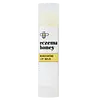What's inside
What's inside
 Key Ingredients
Key Ingredients

 Benefits
Benefits

 Concerns
Concerns

 Ingredients Side-by-side
Ingredients Side-by-side

Polyethylene
AbrasivePolybutene
Bis-Diglyceryl Polyacyladipate-2
EmollientButyrospermum Parkii Butter
Skin ConditioningHydrogenated Polyisobutene
EmollientMyristyl Myristate
EmollientCera Alba
EmollientOctyldodecanol
EmollientRicinus Communis Seed Oil
MaskingCetyl Alcohol
EmollientLimnanthes Alba Seed Oil
Skin ConditioningCetyl Palmitate
EmollientGlycerin
HumectantRibes Nigrum
EmollientEchium Lycopsis Fruit Oil
Skin ProtectingCoriandrum Sativum Fruit Oil
MaskingPrunus Armeniaca Kernel Oil
MaskingTocopheryl Acetate
AntioxidantHydroxypalmitoyl Sphinganine
Skin ConditioningPentaerythrityl Tetraoleate
EmollientHydrocinnamyl Cinnamate
PerfumingCI 77891
Cosmetic ColorantStearyl Alcohol
EmollientGlycine Soja Oil
EmollientMyristyl Alcohol
EmollientCitric Acid
BufferingTocopherol
AntioxidantAscorbyl Palmitate
AntioxidantPolyethylene, Polybutene, Bis-Diglyceryl Polyacyladipate-2, Butyrospermum Parkii Butter, Hydrogenated Polyisobutene, Myristyl Myristate, Cera Alba, Octyldodecanol, Ricinus Communis Seed Oil, Cetyl Alcohol, Limnanthes Alba Seed Oil, Cetyl Palmitate, Glycerin, Ribes Nigrum, Echium Lycopsis Fruit Oil, Coriandrum Sativum Fruit Oil, Prunus Armeniaca Kernel Oil, Tocopheryl Acetate, Hydroxypalmitoyl Sphinganine, Pentaerythrityl Tetraoleate, Hydrocinnamyl Cinnamate, CI 77891, Stearyl Alcohol, Glycine Soja Oil, Myristyl Alcohol, Citric Acid, Tocopherol, Ascorbyl Palmitate
Ingredients Explained
These ingredients are found in both products.
Ingredients higher up in an ingredient list are typically present in a larger amount.
Tocopherol (also known as Vitamin E) is a common antioxidant used to help protect the skin from free-radicals and strengthen the skin barrier. It's also fat soluble - this means our skin is great at absorbing it.
Vitamin E also helps keep your natural skin lipids healthy. Your lipid skin barrier naturally consists of lipids, ceramides, and fatty acids. Vitamin E offers extra protection for your skin’s lipid barrier, keeping your skin healthy and nourished.
Another benefit is a bit of UV protection. Vitamin E helps reduce the damage caused by UVB rays. (It should not replace your sunscreen). Combining it with Vitamin C can decrease sunburned cells and hyperpigmentation after UV exposure.
You might have noticed Vitamin E + C often paired together. This is because it is great at stabilizing Vitamin C. Using the two together helps increase the effectiveness of both ingredients.
There are often claims that Vitamin E can reduce/prevent scarring, but these claims haven't been confirmed by scientific research.
Learn more about Tocopherol